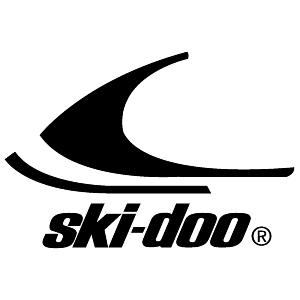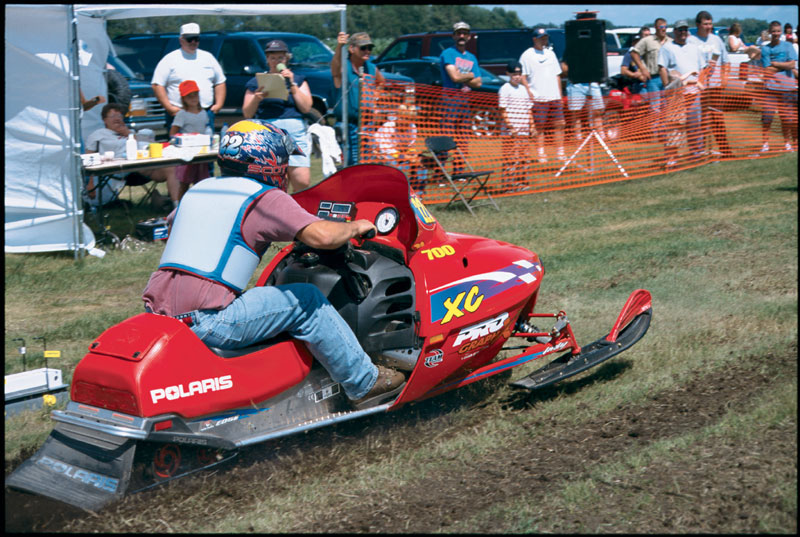2012 Ski-Doo MX Z E-TEC 600 H.O. X vs. Polaris 600 Rush Pro-R
 Snow Goer lined up a 2012 600 Rush Pro-R and a MX Z E-TEC 600 H.O. X to see how the machines compare to one another. Each machine is remarkable for how well they perform in a wide variety of conditions. They feel differently from each other, swallow the bumps differently and drive through turns differently, not to mention their engines have unique characteristics.
Snow Goer lined up a 2012 600 Rush Pro-R and a MX Z E-TEC 600 H.O. X to see how the machines compare to one another. Each machine is remarkable for how well they perform in a wide variety of conditions. They feel differently from each other, swallow the bumps differently and drive through turns differently, not to mention their engines have unique characteristics.
Handling And “Feel”
The 2012 Polaris 600 Rush Pro-R and Ski-Doo MX Z E-TEC 600 H.O. X each has their own feel from within the cockpit. The Rush feels big and tall with its fuel tank rising high and narrow between the driver’s legs, especially for riders who are a few inches less than 6 feet tall. Stand up and look toward the nose of the Rush and you’ll see its long and narrow hood. The seat is firm and narrow to allow easy side-to-side transitions for riders with an inseam more than 32 inches, but short folks first need to boost themselves up before they can slide over and lean into a turn. The handle bar and running boards are solid and sturdy, making the machine feel durable.
Sit down on the Ski-Doo and you’ll feel a smaller snowmobile. The seat is lower, flatter and softer, and the fuel tank sits under a smooth, sculpted cover that doesn’t invade the driver’s personal space. Distances from the seat to the handlebar to the running boards seems perfect, especially for riders who say the Polaris is too big. This gives a Ski-Doo driver a feeling that he or she can work in unison with the sled to thread sharp curves and intricate sections of trail more easily than the big Polaris.
Rush Pro-R riders are active in the handling of the machine instead of going along for the ride with their butts planted on the seat, and because of this the Rush should appeal to snowmobilers who enjoy being active behind the handlebar. Steering the Polaris requires more muscle from the driver than the Ski-Doo, but it responds well to what the driver asks it to do. Moving forward and back, left and right affects weight transfer and cornering ability on the Rush.

Whether it was a 20 mph switchback or a 60 mph curve, we pushed the MX Z harder into corners because it had more control during entry and while braking. The Doo’s front-end manners are agreeable with lighter steering and a more settled-in feeling that carves through high-speed turns better than the Rush. Better ergonomics are another reason riders can get through slow or fast turns more quickly on the MX Z.
Steering is easier on the Ski-Doo and handling is more precise. We could point the sled to any spot on the trail we wanted it to go, and it went there while the Polaris was slower to engage. The wide arc of the Rush’s steering is another factor that makes the sled feel big — lopping a half-inch off each end of the handle bar would help fix this. It’s important to note that our sample MX Z had the Ice Ripper XT track with lug studs, but past experience riding both platforms without traction enhancement has proven the Ski-Doo has superior handling.
Suspensions
What the Polaris gives up to the Ski-Doo in terms of precision, it gains in suspension ability — especially the front suspension. The IQ front suspension has been the most stable setup in snowmobiling since it debuted in 2005, and we still think it inspires the most confidence for hauling ass over bumps. It’s predictable and it tracks straight. The Rush isn’t affected by front-end hits taken at weird angles — the skis don’t change direction. Instead the suspension covers up the driver’s mistakes and soaks up bumps without giving feedback to the handlebar.
The Rush rear suspension has a springy, playful feel when aggressively hitting rounded moguls that are at least 1 foot tall. Drivers felt interactive and connected with the machine when hitting those bumps in excess of 60 mph. The Ski-Doo rear suspension rebounded more harshly, and it felt like there was physically less machine separating riders from the bumps.
Initial travel over small bumps with the rMotion suspension is managed by the torsion springs rather than involving the rear shock. The MX Z rear suspension out-performs the Rush’s suspension through short, choppy bumps, deadening them so riders can mow them down at a faster speed than one could on the Rush.

The Rush has revised rear suspension geometry and a lighter spring that, collectively, improves the Polaris rear suspension performance through the chop, but we still felt too much feedback for our tastes, which makes the Pro-Ride skid feel harsher through the chop than the rMotion.
Engine Impressions
Bombing down a rough trail on the 600 Rush Pro-R is especially fun and the sled seems more playful than the MX Z because of its power delivery. Polaris riders will feel strong torque and a firm tug down low, which makes it easy to lighten the skis off of rollers and small drop-offs in the trail, or when roosting out of corners.
Pull from the Rotax didn’t feel as strong, but the Ski-Doo’s power train feels smoother, which makes the whole vehicle feel more precise and polished. Bear in mind that we rode these sleds in West Yellowstone, Montana, where elevation is about 6,700 feet above sea level, and the Polaris folks might have had their machine calibrated more accurately than did the boys at the Ski-Doo camp. Or, maybe it’s because the Polaris is, in fact, quicker ….
Decisions, Decisions
Flatter cornering and a better ride are the result of the new front suspension and revised Pro-Ride rear suspension on the Pro-R. When comparing the rMotion to the SC-5 skidframe it replaces, there is no comparison. The new suspension is much better than the old one — hands down.
If low- and high-speed handling is most important to you, you’ll be happiest owning the Ski-Doo MX Z E-TEC 600 H.O. X. Steering is light and the sled feels much smoother, softer and quieter — all are qualities that make it less tiring to ride than the Polaris. The REV-XP chassis is a better fit for smaller people, so factor that into your decision.
If bumps make you smile and you need a wider margin for error when you smash into the big moguls, go for the Polaris 600 Rush Pro-R. It has a lively engine and higher stance that promotes bombing through the big moguls with the throttle pressed against the handgrip. Its bigger dimensions offer a little more protection against the elements, too.
— Andy Swanson




